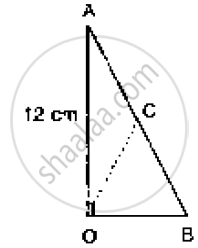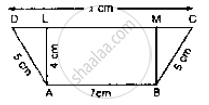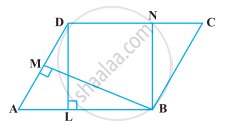Advertisements
Advertisements
प्रश्न
The table given below contains some measures of the rectangle. Find the unknown values.
| Length | Breadth | Perimeter | Area |
| 13 cm | ? | 54 cm | ? |
उत्तर
l = 13 cm
p = 54 cm
Perimeter = 2(l + b) units
54 = 2(13 + b) cm
`54/2` = 13 + b
27 = 13 + b
b = 27 – 13
b = 14 cm
Area = l × b sq.unit
= 13 × 14 cm2
A = 182 cm2
Completing the unknown values in the table.
| Length | Breadth | Perimeter | Area |
| 13 cm | 14 cm | 54 cm | 182 cm2 |
APPEARS IN
संबंधित प्रश्न
In the below fig. ∠AOB = 90°, AC = BC, OA = 12 cm and OC = 6.5 cm. Find the area of
ΔAOB.

In the below fig. ABCD is a trapezium in which AB = 7 cm, AD = BC = 5 cm, DC = x cm,
and distance between AB and DC is 4cm. Find the value of x and area of trapezium ABCD.

Two parallelograms are on the same base and between the same parallels. The ratio of their areas is
The perimeter of a triangle ABC is 37 cm and the ratio between the lengths of its altitudes be 6: 5: 4. Find the lengths of its sides.
Let the sides be x cm, y cm, and (37 - x - y) cm. Also, let the lengths of altitudes be 6a cm, 5a cm, and 4a cm.
The side of a square is 3.6 cm; find its area.
The King was very happy with carpenters Cheggu and Anar. They had made a very big and beautiful bed for him. So as gifts the king wanted to give some land to Cheggu, and some gold to Anar. Cheggu was happy. He took 100 meters of wire and tried to make different rectangles.
He made a 10 m × 40 m rectangle. Its area was 400 square meters. So he next made a 30 m × 20 m rectangle.
- What is its area? Is it more than the first rectangle?
In the following figure, the area of parallelogram ABCD is ______.

Area of a rectangle with length 5 cm and breadth 3 cm is ______.
Find the area of the following figure by counting squares:

Find the area of the following figure by counting squares:

